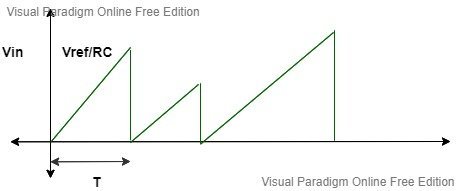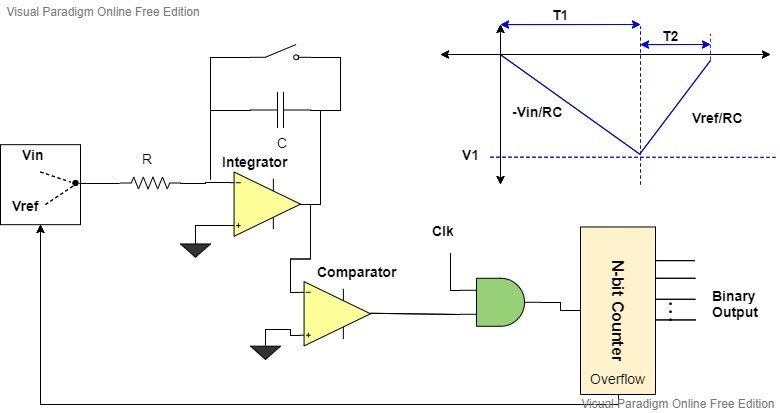In this tutorial, we will discuss slope-type or integration-type ADCs. In the last tutorial, we discussed successive approximation and flash-type ADC. There are two types of slope ADCs: single slope and dual slope. Firstly, we will discuss single slope, and after that, we will see the workings of dual-slope integration ADC.
Slope Type ADC Introduction
A single and dual slope ADCs are the types that digitize the analog signals using integrator circuits, and the design of an integrator circuit uses operational amplifiers. In this type, we generate a sawtooth waveform using an op-amp as an integrator. Then we compare the output of the sawtooth waveform against the analog input using a comparator circuit to generate a digital output.
These have a high resolving power but are quite slower in terms of conversion speed than other analog to digital converters. Their major application is the multimeter. This article shares the workings of single and dual ADCs, their benefits, downsides, and applications.
Single Slope ADC (Integrated ADC )
A dual slope ADC is preferable to a single slope analog-to-digital converter. For a clear conception of the dual-slope ADC, we will study the single slope ADC first. It consists of an integrator and a comparator.

The input voltage is applied to the positive terminal of the comparator, while the reference voltage is obtained after being integrated through the integrator. The circuit then compares both voltages through the comparator. The input voltage is a function of time t. The integration of the reference voltage keeps going until the output voltage of the comparator becomes equal to the input voltage.
The general output voltage of the integrator is:
VO = 1 / R * C (-Vref) dt
In the equation, we can see that the reference voltage is negative, so the slope of the output voltage after integration turns out to be positive.
The output voltage of the integrator at any given time is:
VO = T * Vref / R * C
At time T, the output voltage is equivalent to the input voltage. So, we can say:
Vin = T * Vref / R * C
As the reference voltage, resistor R, and capacitor C are fixed for a given analog-to-digital converter, the input voltage is directly proportional to time.
Schematic Diagram
Below is the schematic diagram of a single slope analog-to-digital converter:

It consists of an integrator, a comparator, an AND gate, and a counter that gives us the binary outputs. The output of the comparator passes through the AND gate. Whenever the output of the comparator is high, which means when the reference voltage is less than the input voltage, clock pulses are given to the counter through the AND gate, and the counter starts counting.
Single Slope ADC Working Principle
Before converting the analog input into binary output, the counter is reset to zero. The input voltage and an integrated reference voltage are applied to the comparator. When the conversion begins, the reference voltage is initially less than the input voltage. The output of the comparator is high, and because of this, the counter receives clock pulses, and the counter starts the counts. So, when the integrated reference voltage becomes equal to the applied input voltage, the comparator changes its state from high to low. The output of the AND gate becomes low, the counter no longer gets any clock pulses, and the count stops. Whatever count is then available on the counter will be proportional to the input voltage.

This circuit also includes a switch known as the reset switch. It gets closed shortly when the comparator’s output is low and makes sure that there is no leftover charge across the capacitor to avoid any errors. This is the process through which the single slope ADC transforms the given analog signal into a digital signal as an output.
Graphical Representation
The graphical representation depicts the effect on input voltage and resistance on the graph.

The above graph shows the time taken for integration with respect to the applied input voltage. The reference voltage and RC are constant, which is why the slope, i.e., Vref/RC, is constant. The input voltage only affects the time. The higher the input voltage, the more time it takes for the integration process, while the slope remains the same.
As it is clear from the graph, this ADC has a single slope, which is why we refer to it as a single-slope ADC.
Effect of RC

If the input voltage is fixed and R or C changes, then the slope changes. Despite constant input, we will achieve different levels of integration over time. If the value of R reduces, then the time taken by the integrator circuit to reach the input voltage will decrease as well.
This value of RC changes with time due to external factors like temperature, etc., which is a major reason for its poor accuracy and leads us to its solution, which is a dual slope ADC.
Dual Slope ADC
The integrator of a dual slope ADC converter has a switch at its input side that can either connect to a reference voltage or an input voltage. During the initial conversion, the switch connects to the input voltage, and the integrator integrates the input voltage until its output equals the applied voltage.

If the output voltage is V1 at time T1, then we can write V1 as:
VO = -1/RC Vin dt
V1 = -T1*Vin/RC
After time T1, the switch connects to the reference voltage, and the circuit integrates the respective voltage. The diagram shows that the given reference voltage is negative, yet it is usually greater than the input voltage.
As negative reference is applied, the integrator integrates in a positive direction and keeps on integrating until the output is equal to the zero voltage. The time taken is represented by T2.

After time T1, the integrator’s output is:
VO = -1 / RC -Vref dt + Vinitial
We can write the equation for time T2 as:
VO = -T2 * (-Vref) / RC + V1
Where V1 is the initial voltage across the capacitor and VO is the total output voltage across the integrator in total time T1 + T2.
If we replace V1 by its value in the above equation, then it becomes:
VO = T2 * (Vref) / RC + (-T1 * Vin / RC)
The output would be equal to zero after T1+T2. The equation becomes:
T2*(Vref)/RC +(-T1*Vin/RC)=0
T2=T1*Vin/Vref
In a dual slope ADC, T1 and the reference voltage are constant, which gives the result that the time T2 is directly proportional to the input voltage. If the input voltage changes, T2 also changes. This is represented through the graph below.
Dual Slope ADC Working Principle

The integrator’s output connects to the negative terminal of the comparator, and the positive terminal of the comparator connects to the ground. At the start of the conversion, the input voltage is connected to the integrator. The integrator integrates it in a negative direction. When compared with the ground, the inverting terminal is negative with respect to the non-inverting terminal, so the output of the comparator becomes high. Just like the single slope, the AND signal then provides the clock pulses to the n-bit counter and starts counting from zero onwards until overflow becomes 1. The counter takes 2^N clocks to integrate the input signal.
When the circuit detects an overflow, the switch automatically toggles and joins the negative reference voltage. As the reference voltage is negative, the integrator begins integrating in the positive direction and repeats the same procedure. This time, the counter will stop counting when the output of the comparator gets low. At that particular time, the binary output of the n-bit counter would be directly proportional to the time T2. In this way, the dual-slope ADC does the conversion.
The total conversion time of this ADC is given by
Ttotal = 2^N*Tc + T2
Ttotal = 2^N*Tc + N*Tc
Where Tc is the clock duration.
If both slopes are equal or we say the input voltage is the same as the reference voltage, the total time becomes
2^(N+1)*Tc
Advantages
- It provides better noise immunity than other ADC types.
- It also has good accuracy.
- It averages the input signal.
Disadvantages
- The accuracy demands highly precise external components.
- This type of ADC slows down with an increase in resolution, which is why its use is not common in data acquisition.
Applications
| Single Slope ADC | Dual Slope ADC |
|---|---|
| Temperature Transducers | Data Acquisition Systems |
| Digital Multimeters | Instrumentation |
| Battery Monitoring | Audio Equipment |
| Low Power Applications | Power Metering |
Conclusion
In conclusion, this tutorial provides an in-depth overview of single and dual slope ADCs. It provides a schematic diagram along with their working principles and effects to help us better understand the concept. It also covers the advantages, disadvantages, and applications of the ADC. Hopefully, this was helpful in broadening your knowledge of the types of ADCs.
You may also like to read:
- R-2R Ladder DAC – Explained with Example Circuit Diagram
- ADC STM32F4 Discovery
- Binary Weighted Resistor DAC
- ADC TM4C123G Tiva C Launchpad
- PIC Microcontroller ADC
- Display ADC value on 4-digit 7-Segment Display using Pic Microcontroller
- HX711 24-Bit Analog-to-Digital Converter (ADC) for Weigh Scales
- ICL7107 ADC Display Driver
- ADC0804 ADC
- ADS1115 I2C external ADC with ESP32 in Arduino IDE
This concludes, today’s article. If you face any issues or difficulties, let us know in the comment section below.
VO = T * Vref / R * C
Here’s where you lost me. Would have thought it would be: Vo = (Vref/(RC))t. No idea where the T came from…it is tau the RC time constant?